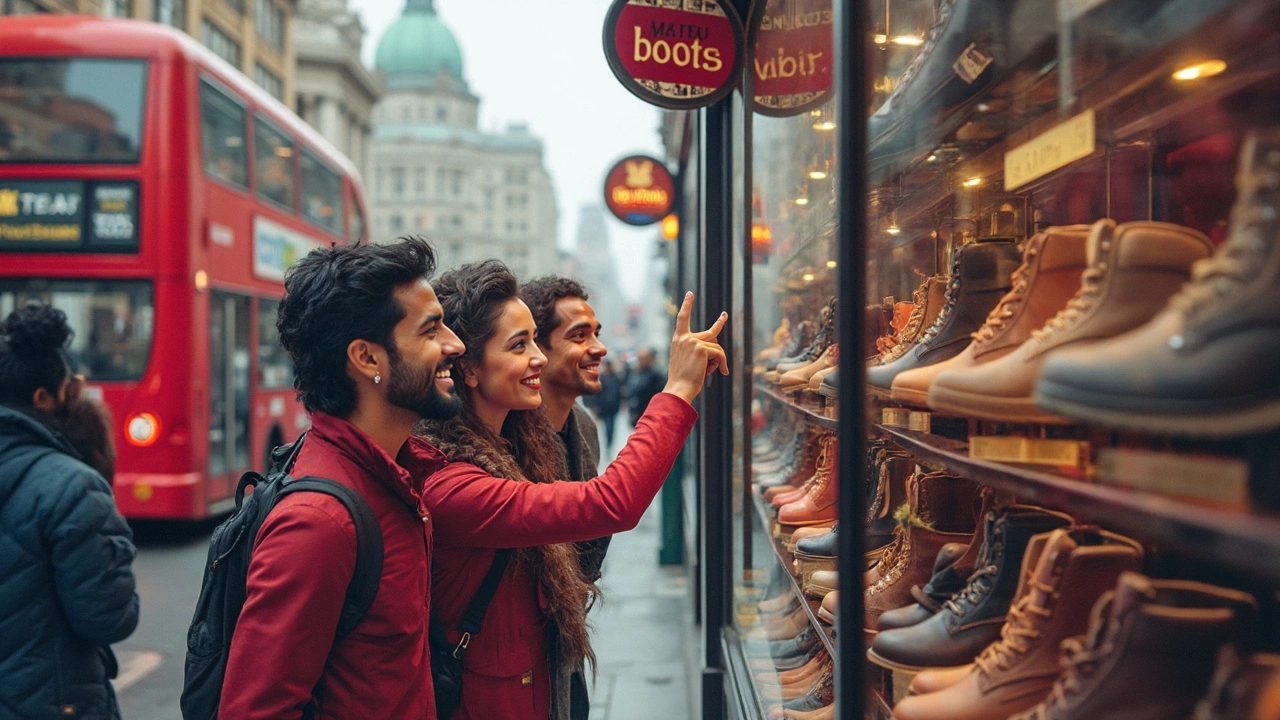Ever land in the UK, ask for 'boots' at a shop, and get a funny look? It happens, especially if you mix up your shoe terms. In Britain, 'boots' are exactly what you think—chunky footwear that covers your ankle or more. The word covers everything from muddy hiking boots to stylish Chelsea boots.
But don’t call trainers 'boots.' Over there, trainers mean sneakers—those comfy, laced-up shoes everyone wears to the gym or for a casual day out. If you walk into a store and ask for boots but really want trainers, you’ll end up with something better suited to a rainy day hike.
If you’re shopping, try being specific. Say 'ankle boots' or 'walking boots' if that’s what you want. If you need something for running or exercise, always use 'trainers.' Brits rarely say 'sneakers'—that’s one quick way to stand out as a tourist. Stick with 'trainers,' and you blend right in.
- Boots vs. Trainers: What’s the Difference?
- How Brits Actually Use the Term 'Boots'
- Popular Types of Boots in the UK
- Real-Life Tips: Shopping for Shoes in Britain
- Regional Variations and Fun Facts
Boots vs. Trainers: What’s the Difference?
You’ll notice straight away that shoes in the UK get split into very clear camps—boots and trainers. Sounds simple, but there are a few quirks that trip people up, especially if you’re used to different lingo.
British English keeps things straightforward: 'boots' are those solid shoes that usually cover your ankles and sometimes go much higher. Think Doc Martens, hiking boots, or anything you’d wear in dodgy weather. Most boots are made to tough it out—work boots, Chelsea boots, even winter boots. They're more about protection and style than sports or running.
Now, flip to 'trainers.' These are the UK’s version of sneakers. Lightweight, breezy design, built for running, sports, or just walking about town. Brands like Adidas, Nike, and Puma sell loads of trainers over here—just don't expect anyone to call them sneakers, because that's firmly in American territory.
- If it covers your ankle and is sturdier, Brits call it a boot.
- If it’s soft, flexible, and usually for sport or casual wear, it’s a trainer.
- Never say 'running boots.' That combo doesn’t exist to a Brit. Use 'running trainers' or just 'trainers.'
Here’s a quick side-by-side to keep things crystal clear:
| Type | Name in UK | Typical Use |
|---|---|---|
| Solid, covers ankle | Boots | Walking, hiking, working, style (Chelsea, biker boots) |
| Soft, below ankle | Trainers | Gym, running, casual |
| High tops (sports) | High-top trainers | Basketball, athletics, fashion |
When you’re shoe shopping or just chatting, remember these basics and you’ll never walk into a shop and ask for the wrong thing by accident.
How Brits Actually Use the Term 'Boots'
In the UK, when someone says 'boots', you can almost always bet they mean tough or protective footwear that wraps around or above the ankle—never 'trainers.' The word covers all kinds, whether you’re talking about rain boots for stormy days, sturdy 'work boots' for job sites, or the super-popular Chelsea boots you’ll spot in almost every high street shop. Don’t get thrown off, though: you’ll never hear a Brit call their running shoes 'boots.' That would just sound odd.
'Boots' in Britain are all about the style or use. They’re what you grab for snow, mud, rain, or even dressing up for a night out. People specify what type by saying things like 'wellies' (for Wellington boots, usually made of rubber for wet weather), 'ankle boots,' or 'walking boots.' The versatility in the word mostly comes from the type; the clue is in the prefix.
The main thing that trips up visitors is the British English split between 'boots' and other shoes. So, if you're trying to sound local and actually get what you want, use their lingo. Here’s a quick cheat sheet Brits live by:
- 'Boots' = Anything covering at least the ankle (rain, hiking, or fashion boots)
- 'Trainers' = Sporty, rubber-soled shoes (what Americans call sneakers)
- 'Wellies' = Tall rubber boots, perfect for rainy weather and muddy festivals
- 'Chelsea boots' = Sleek, ankle-high boots, often leather or suede
- 'Work boots' = Heavy-duty, reinforced footwear
If you browse websites like Marks & Spencer or Next, you'll notice separate categories for 'boots' and 'trainers.' Shops keep it that way too, to avoid confusion. Just for fun, check out this table showing the most popular types of boots and who wears them the most:
| Boot Type | Main Users | Usual Purpose |
|---|---|---|
| Wellies | Kids, dog walkers, festival goers | Wet/muddy conditions |
| Chelsea Boots | Young professionals, fashion-conscious | Smart/casual wear |
| Walking Boots | Hikers, outdoor workers | Rough terrain |
| Work Boots | Builders, tradespeople | Safety on job sites |
| Ankle Boots | Women (mainly), style-focused | Everyday wear |
One last thing: if you’re at a football match in the UK and hear 'boots,' they're talking about football boots (what Americans call cleats), not what you'd wear to Tesco. Context makes all the difference.

Popular Types of Boots in the UK
If you wander through streets in London, Manchester, or Glasgow, you’ll spot loads of different boots. Brits love boots for all sorts of weather and occasions. They’re not just practical—they’re a style staple. Let’s break down the most common types you’ll bump into.
- Chelsea boots: Classic and everywhere. Smooth sides, elastic panels. Slip them on for work or hanging out. Almost every UK high street shop sells these.
- Wellington boots (Wellies): The rain never ends, so Wellies are a must. Dubbed ‘Wellies,’ they’re rubbery, waterproof, usually reaching halfway up your shin. Country folks wear them for walking the dog or trekking through muddy fields, but city dwellers rock them at music festivals too.
- Walking boots: Brits go hiking a lot—think Lake District or Scottish Highlands. Walking boots are rugged with thick grips. Look for brands like Berghaus or Scarpa in outdoor shops.
- Desert boots: Originally made famous by Clarks, these lace-up suede boots are comfy with a flat sole. Good for a smart-casual vibe.
- Brogue boots: Classic leather boots but fancier, punched-hole details up the side. Popular for both work and more formal nights out.
Here’s a quick look at the main types and what makes them popular:
| Type | Main Use | Popular Brand |
|---|---|---|
| Chelsea Boot | Everyday, smart-casual | Dr. Martens |
| Wellington Boot | Rain, festivals, outdoor mess | Hunter |
| Walking Boot | Hiking, countryside | Berghaus |
| Desert Boot | Smart casual, comfort | Clarks |
| Brogue Boot | Dressier events, work | Grenson |
Don’t forget, in the UK, when people mention boots, it never means trainers. Some shop sales data from 2023 showed that Hunter Wellies and Dr. Martens Chelsea boots rank in the top-selling spot during autumn and winter. So if you want to blend in, grab a pair of these—they’re both functional and proper British style icons.
Real-Life Tips: Shopping for Shoes in Britain
Shoe shopping in the UK is different from what you might expect if you’re used to American terms and sizing. Walk into any shop on Oxford Street or your local high street, and you’ll want to have your shoe lingo right. The most important thing? Don’t mix up your trainers, boots, and shoes.
If you ask for boots, you’ll get footwear that covers your ankle—anything from Dr. Martens to waterproof hiking boots. Nobody is going to hand you trainers if you say ‘boots,’ so be specific. For running, walking, and gym shoes, always say ‘trainers.’ The term ‘sneakers’ usually gets you puzzled looks or, at best, a quiet chuckle from behind the counter.
UK shoe sizes aren’t the same as US ones. A UK men’s 9 is about a US men’s 10, for example. Always ask to try the shoes on or check their size guide. In most big-brand stores, staff expect this question; they keep conversion charts handy for tourists.
- Always try on both shoes. UK shops often recommend this because even the same size can fit a bit different between brands.
- Look for ‘wide fit’ or ‘narrow fit’ labels if you need them—many British stores cater for all foot shapes.
- If you’re after waterproof outdoor boots, ask for ‘wellies’ (short for ‘Wellington boots’) if you mean rubber boots. If you say just ‘boots,’ you might end up with something fashionable rather than practical.
- Sales staff will call the athletic aisle the ‘trainers section.’ Ask to be pointed there for anything sports-related.
Some shops in the UK, like JD Sports or Sports Direct, sometimes call certain casual shoes ‘plimsolls’—especially simple canvas shoes. It’s a bit old-school, but you still hear it. Boots are all the rage in autumn and winter, but ‘trainers’ are an all-year staple. Keep these words in your toolkit, and you’ll shop in Britain like a local.

Regional Variations and Fun Facts
It’s easy to think everyone in the UK speaks the same when it comes to shoes, but local slang proves otherwise. In London, ask for 'boots' and the shop staff will reach for Dr. Martens, Chelsea boots, or wellies without batting an eyelid. In the North, you’ll still get boots—but listen closely and you might hear terms like 'wellies' for Wellington boots, especially if there’s mud involved.
In parts of Scotland, 'tackety boots' used to mean old-school football boots with studs, while folks in Liverpool sometimes call any type of tough, work-ready boots 'kickers,' thanks to a popular brand. Wales loves a pair of 'walking boots,' especially with all those hills and hiking spots. Across the UK, 'trainers' almost always means athletic shoes, but in Northern Ireland, older generations still use the word 'gutties' for plimsolls or cheap trainers.
Here’s a quick look at some popular terms and where you might hear them:
- Boots – All over the UK for ankle and higher footwear.
- Wellies – Common in England and Wales for waterproof Wellington boots.
- Kickers – Slang in Liverpool for sturdy school or work boots.
- Tackety boots – Old football boots, especially in Scotland.
- Gutties – Classic in Northern Ireland for plimsolls/trainers.
If you’re after stats, a recent shoe retailer survey found that Brits buy on average 2.6 pairs of boots per year, beating out their American cousins who average around 2 pairs. When it rains (which is often), wellies sales spike by 30% in the autumn, especially in countryside regions.
| Region | Common Boot Nickname or Term | Special Boot Type |
|---|---|---|
| London | Boots | Chelsea Boots |
| Scotland | Tackety Boots | Football Boots |
| Liverpool | Kickers | School/Work Boots |
| Northern Ireland | Gutties | Plimsolls/Trainers |
| England/Wales | Wellies | Wellington Boots |
A good tip: don’t just ask for 'boots.' Drop in a phrase like 'Do you have any wellies?' or 'Looking for Chelsea boots.' You’ll sound like you know your stuff—and you’ll walk out with exactly what you wanted. British English is all about getting specific, especially with footwear.

